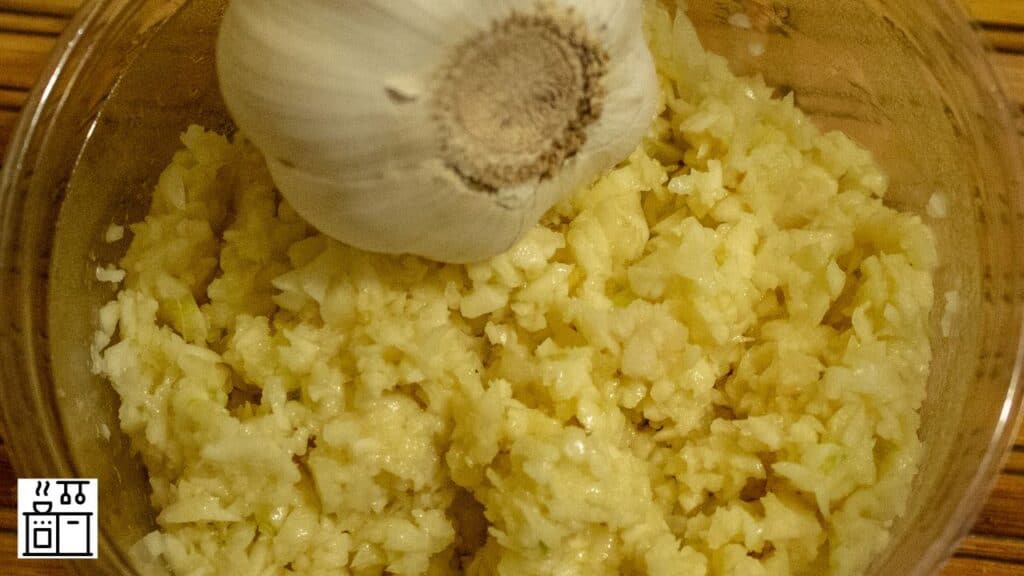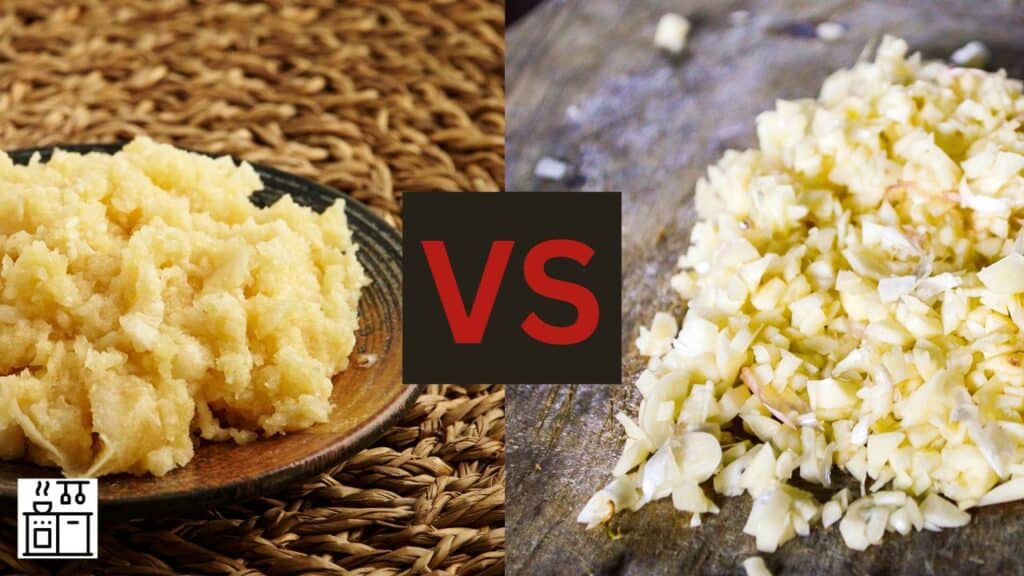Grated garlic has a paste-like texture and offers a strong flavor. It’s made using a rasp-style grater or microplane and is best for smooth sauces or dressings. The grating process releases a more powerful garlic taste.
Minced garlic, on the other hand, is finely chopped using a knife or food processor. It provides small, distinct pieces and gives a milder garlic flavor. It’s suitable for stir-fries or sautés. The chopping process results in a less intense flavor compared to grated garlic.
When deciding between grated or minced garlic, consider the dish you’re making. Ask yourself whether you want a strong or mild garlic flavor and whether you need a smooth texture or small pieces. The choice between grating and mincing impacts the texture, flavor intensity, and overall outcome of your dish.
- What Are the Pros and Cons of Grated Garlic?
- What Are the Pros and Cons of Using Minced Garlic?
- How Do Grated and Minced Garlic Affect Recipes?
- How Does the Form of Garlic Affect Its Health Benefits?
- What Are the Pros and Cons of Using Pre-Minced Garlic?
- How to Mince Garlic with Grater?
- What Should You Choose, Grated or Minced Garlic?
What Are the Pros and Cons of Grated Garlic?
Here are the pros and cons of using grated garlic.
Pros of Grated Garlic
Grated garlic has several advantages.
Firstly, it imparts a stronger flavor to your dishes because grating breaks down more cell walls of the garlic, releasing a more robust taste.
It provides a smooth, paste-like texture that mixes well into sauces, dressings, and spreads.
Grating garlic might also offer more health benefits due to the increased production of allicin, an antioxidant.
Cons of Grated Garlic
While grated garlic has its advantages, it also has several disadvantages.
Firstly, it burns easily due to its fine texture, making it problematic when exposed to heat. Therefore, it’s recommended for recipes where the garlic is raw or lightly cooked.
Grated garlic doesn’t fit all recipes. If your dish needs a less prominent garlic flavor or texture, such as salads or raw dips, grating may not be the best choice.
Grating garlic also requires a specific tool – a rasp-style grater or microplane, which not everyone has in their kitchen. This may need an additional investment.
What Are the Pros and Cons of Using Minced Garlic?
Now, let’s talk about minced garlic.
Understanding the pros and cons of minced garlic can help you determine if it suits your cooking requirements.
Pros of Minced Garlic
Minced garlic is a convenient and versatile ingredient. It’s already peeled and chopped, which saves you time when preparing meals.
You can use it in various dishes, from stir-fries to pasta sauces.
Minced garlic also has health benefits due to compounds like allicin, which can strengthen your immune system. It also enhances the flavor of your dishes.
Cons of Minced Garlic
Using minced garlic in your cooking can have some disadvantages. Its flavor and nutritional value may decrease over time due to exposure to air and heat.
Minced garlic may not taste as good as fresh garlic. Some cooking experts believe that minced garlic’s flavor is inferior to fresh minced garlic.
Pre-minced garlic also often includes additives and preservatives like citric acid and phosphoric acid. These are used to keep the garlic stable on store shelves.
How Do Grated and Minced Garlic Affect Recipes?
Both, grated and minced garlic, can alter the taste and texture of your meals differently.
Grated Garlic in Recipes
Grated garlic is recommended for garlic yogurt sauce, tahini sauce, and garlic butter due to its smooth, paste-like texture and robust flavor.
Its fine consistency ensures that the garlic mixes well into the dish, improving the overall taste without leaving any chunks.
Here’s how grated garlic affects various dishes:
- Garlic Yogurt Sauce: Grated garlic’s smooth texture enhances this sauce by infusing the yogurt with a strong yet balanced flavor.
- Tahini Sauce: Grated garlic complements the creamy tahini well, ensuring a lump-free and flavorful mixture.
- Garlic Butter: The paste-like quality of grated garlic allows for quick melting and even distribution throughout the butter.
- Raw or Gently Cooked Dishes: Grated garlic is suitable for recipes that don’t need high heat due to its stronger flavor and tendency to burn.
Minced Garlic in Recipes

Stir-fries and marinades are dishes that benefit from finely chopped ingredients like minced garlic. Minced garlic adds a strong yet balanced flavor.
It’s ideal for cooked dishes as it’s less prone to burning than grated garlic.
Use it in sautéed dishes or pasta sauces. The small pieces blend with the dish, enhancing the flavor without being too dominant.
How Does the Form of Garlic Affect Its Health Benefits?
The health benefits of garlic can vary depending on whether it’s grated or minced.
Grated garlic produces more allicin, due to more cell walls being broken down during the grating process. This leads to a stronger flavor and potentially greater health benefits.
On the other hand, minced garlic offers a milder taste and produces less allicin. Although its health benefits may be less substantial, they’re still significant.
Both, grated and minced garlic, support the immune system and heart health, and have antioxidant properties.
So the choice between these two depends on your taste preference and the specific requirements of your recipe.
What Are the Pros and Cons of Using Pre-Minced Garlic?
Using pre-minced garlic has both advantages and disadvantages.
Pros of Pre-Minced Garlic
- Convenience: Pre-minced garlic saves time and effort as it eliminates the need for peeling and chopping garlic cloves.
- Consistency: Pre-minced garlic ensures a consistent size and texture, which can be useful for certain recipes.
- Extended shelf life: Pre-minced garlic usually comes in jars or containers with a longer shelf life compared to fresh garlic cloves.
Cons of Pre-Minced Garlic
- Reduced flavor: Pre-minced garlic tends to have a milder flavor compared to fresh garlic because the process of mincing can cause some of the essential oils to evaporate.
- Quality concerns: The quality of pre-minced garlic can vary, and some brands may include additives or preservatives that can affect the taste or texture.
- Cost: Pre-minced garlic is often more expensive than fresh garlic cloves, especially when considering the amount needed for a recipe.
How to Mince Garlic with Grater?
To mince garlic with a grater, begin by peeling the skin off the garlic clove. This leaves you with the pure clove, ready to be minced.
Next, select a grater, preferably a rasp-style grater or microplane for fine mincing. Position the grater at a slight angle over a bowl or cutting board to collect the minced garlic without making a mess.
Now, hold the peeled clove and gently run it along the grater. Apply consistent pressure and be cautious as you reach the end of the clove to avoid grating your fingers.
Scrape off any garlic stuck to the grater and gather your minced garlic. It’s now ready for use in your recipe.
What Should You Choose, Grated or Minced Garlic?
The choice between grated and minced garlic hinges on your cooking requirements and personal preference.
Grated garlic has a potent flavor and smooth texture, while minced garlic has a milder taste and rougher texture.
Both types maintain garlic’s health benefits, but grated garlic is more potent than minced.
So think about your desired result before choosing grated or minced garlic.

